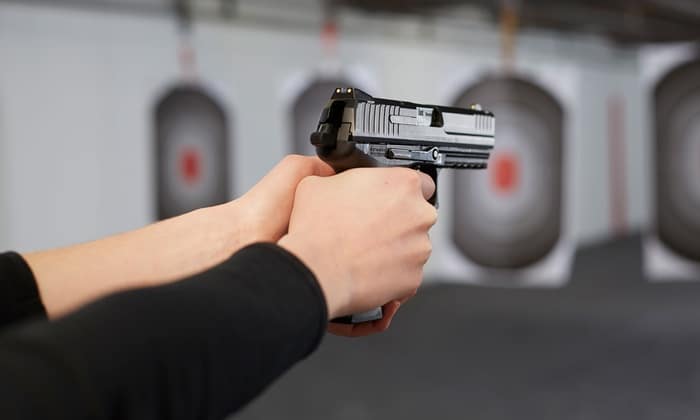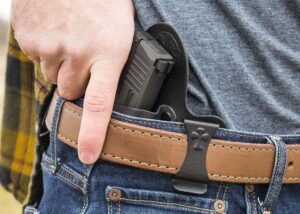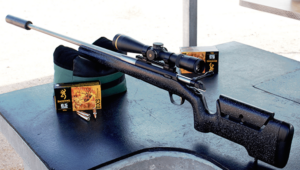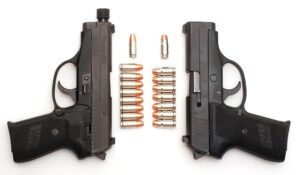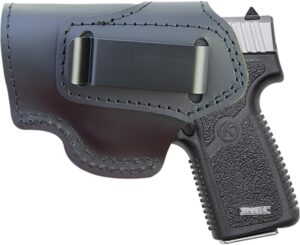Unpack This Article's Arsenal
- What are the 4 Primary Rules of Firearm Safety?
- Firearm Safety Rules – #2: Point Your Firearm in a Safe Direction
- Firearm Safety Rules – #3: Be Aware of Your Target and What’s Behind It
- Firearm Safety Rules – #4: Never Put Your Finger on the Trigger
- Firearm Safety Rules – #5: Bonus Rules…
- 4 Firearm Safety Rules – Conclusion
- Recommended Reading
If you’re new to gun ownership, there are 4 rules of firearm safety you should make a habit of following, every time you pick up a firearm. Even if you’re a veteran owner, a refresher on these rules can’t hurt anything.
These rules, if put in place and used every time you handle a firearm, will pretty much guarantee that you won’t have an accident with your firearms. But, it takes time to make it a habit, so keep practicing until they become second nature.
It’s also a good idea to teach these rules to everyone in your household (with the exception of small children). Even kids as young as 9 or 10 can be taught the necessary firearm rules to respect the firearms in their home.
What are the 4 Primary Rules of Firearm Safety?
Let’s lay out these rules and discuss each one in detail. And keep in mind that these rules also apply when handling airsoft or BB guns, as they can cause injuries as well.
Firearm Safety Rules – #1: Check and Double-Check If Loaded
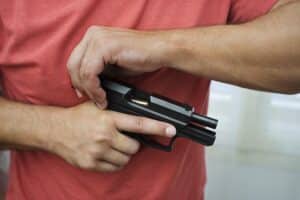
Say you’re in a gun store and the guy behind the counter checks a firearm and then hands it to you. Even though he just checked it, you should still check it yourself.
How to Check if Gun Is Loaded
The method for checking a firearm varies depending on the gun.
How to Check if a Revolver is Loaded?
For revolvers, simply release the cylinder and verify there are no bullets inside. I also look into the barrel; it’s probably a habit because I usually handle only semi-automatics.
Some pocket revolvers, like the North American Arms .22 caliber mini revolver and others, don’t have a swing open cylinder. With these pistols, you’ll need to pull the pin under the barrel to remove the cylinder and check that it’s empty.
Single-action revolvers also don’t have swing open cylinders; instead, these revolvers are loaded one bullet at a time through a loading gate. To check these, you must manually spin the cylinder to check that every chamber is empty.
How to Check if a Semi-Automatic Pistol is Loaded?
Checking a semi-automatic requires an extra step. First, drop the magazine and ensure that it’s empty. You might keep yours loaded at home, and that’s fine.
Just set the magazine aside; don’t put it back in the gun. Then, pull open the slide to check that there’s no bullet in the chamber. You should be able to see light coming down the barrel. Having a great range bag is a good way to keep your gun and magazine separate.
Checking if a Bolt Action Rifle is Loaded
When you’re checking a single-action bolt-action rifle, you should open the bolt and look down the barrel. Single-shot shotguns or double-barrels with a breach should be opened and checked for shells.
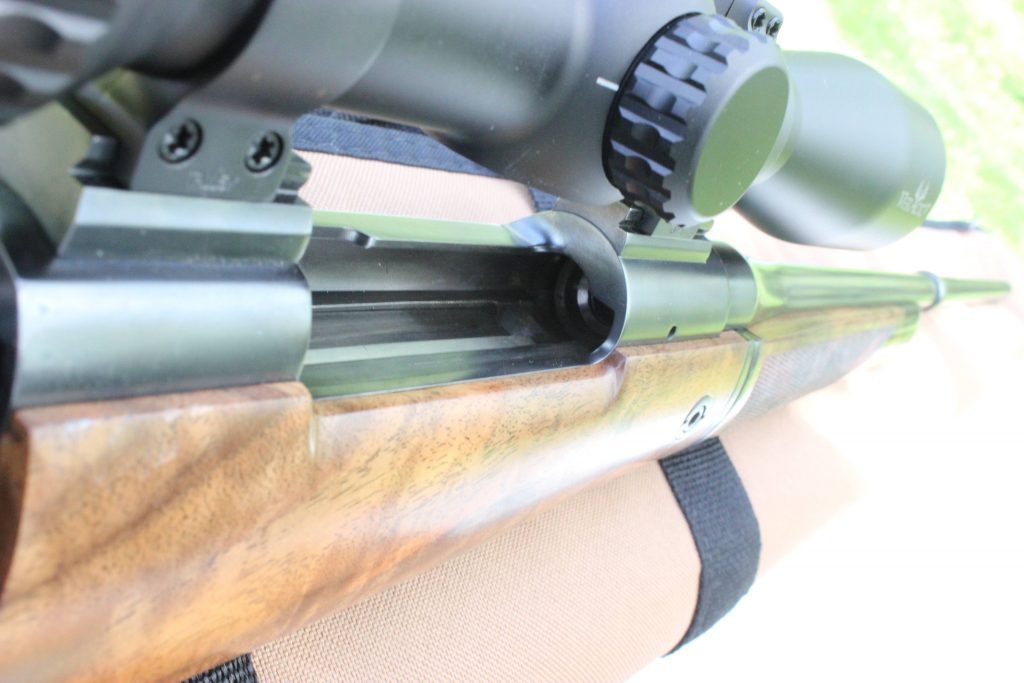
Other rifles use a stripper clip in lieu of a magazine. If there’s no clip in the rifle, pull the bolt back and check the chamber.
Checking if an Assault Rifle is Loaded
Caution must be taken with sub-machine guns like the Thompson .45 rifle because the bolt is always open, and pulling the trigger can close the bolt, resulting in the gun firing. On this design of rifle, accidental discharge can occur when loading or removing the magazine. Always hold the bolt securely when loading or removing the magazine.
In May of 2017, a firearms instructor in Livonia, Michigan accidentally shot a student when he ignored this rule and displayed his gun to the class. He pointed the gun at the door, and when he pulled the trigger, shot a man on the other side of the door.
Children who are old enough and strong enough to pull back the slide, operate a bolt-action rifle, rack a shotgun, or pull a trigger should be taught this rule as well. Impress upon your kids the importance of following this rule.
When you use these methods every time you handle a firearm, you can bet that you’ll never have an accidental discharge of your firearms.
Firearm Safety Rules – #2: Point Your Firearm in a Safe Direction
This sounds like common sense, right? But you’d be surprised at how often gun owners neglect this rule.
When you’re at the range, a safe direction is down ran
Even if you’ve already done rule #1, you should always assume that a weapon is loaded. Therefore, never point a gun at anything that you don’t want to shoot (like a target, or Heaven forbid, an assailant).
If your children are old enough to handle firearms, they should be instructed in this rule as well.
Firearm Safety Rules – #3: Be Aware of Your Target and What’s Behind It
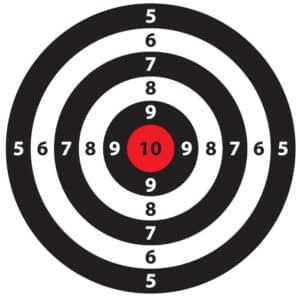
But he neglected firearm safety rule #3, because he wasn’t aware of what was behind the door he aimed at. His bullet penetrated the door and shot a student in the other room. The student was struck in the leg.
If you’re shooting at home, make sure you know the area extending out from your shooting zone. This may include homes behind a small treeline, roads, or sidewalks. Bullets that miss a target or backdrop can travel far before losing their momentum.
Stray Bullet Story
In Seattle Washington in January 2017, a 74-year-old man was struck and killed while asleep in his home. Investigators found bullet holes in the man’s fence and a car outside the house. This is just one of many examples of stray bullets injuring and killing people.
If your kids shoot, they should be taught this as well. Kids instructed with guns are often less likely to accidentally shoot one. Once kids are made aware of the destruction that comes with a firearm, they’ll have much more respect for them.
Always be aware of your target and potential victims behind your target when you’re shooting.
Firearm Safety Rules – #4: Never Put Your Finger on the Trigger
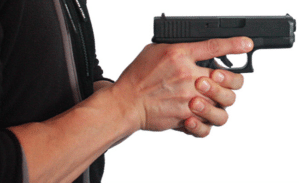
The only time you should ever put your finger on the trigger is if you’re ready and willing to shoot whatever you’re aiming at.
When you’re handling handguns, your trigger finger should be out of the trigger guard and extended along the barrel as if you’re pointing. Some smaller, pocket pistols like the P238 may not have enough space for this, but you need to make sure your finger is away from the trigger.
In the event that you must shoot an assailant, putting your finger on the trigger takes only a split second, so this shouldn’t concern you.
As with the other rules, teach your children this one, too. This will help them grow into responsible gun owners themselves.
Firearm Safety Rules – #5: Bonus Rules…
I’m going to throw a fifth rule in here for you. It’s a two-part rule that everyone who owns firearms should adopt.
Bonus Firearm Safety Rule #1 – Keep Your Weapon Out of the Reach of Children
The first part is to keep your weapon out of the reach of children. If you plan to teach your kids about firearms and firearm safety, but they’re still too young, you should keep your guns well out of reach. For added security, invest in a gun safe, and leave them unloaded or locked when you’re not at home.
According to the Brady Campaign against gun violence, toddlers shot and killed at least 23 people in 2016 in the first part of 2016. An update to the story in October put the number of deaths at the hands of toddlers with firearms at 50. And these numbers are only fatalities, not including non-life-threatening injuries.
With these stories, you can see how important it is for responsible gun owners to keep their weapons out of the reach of small children. And even if you don’t have kids of your own, you may have visitors who do, so keep this in mind whenever children are in your home.
Bonus Firearm Safety Rule #2 – Teach Children the 4 Rules of Firearm Safety
The second part of this rule is to teach children the 4 rules of firearm safety, assuming they’re old enough. Make sure they understand how to operate the firearm so they can perform a safety check, verifying the gun is unloaded. One strategy is to get kids on something a lot less dangerous like a pellet gun, check out our best air rifle review page for more.
Teach them that they should never point a firearm at anyone, and instruct them to look beyond their target and think about what is there that could be a danger. Show them how they should never put their finger on the trigger until they’re ready to shoot.
Even if your kids are well-instructed in firearms safety, remember that their friends may not be. If your child has kids they play with at home, make sure to keep your firearm out of reach, and even better, unloaded and securely locked.
Another thing you might consider is taking young children with you to the range. Make sure they have hearing protection. Let them see what a firearm can do (to a target, a tin can, etc.). Explain that the same thing would happen to a person who is shot.
I know someone whose two daughters were raised around guns. Their parents were in law enforcement. From a young age, the girls watched target practice and were taught never to touch a gun. They learned this lesson so well that when they accidentally knocked a handgun off a table onto the floor, they went to find an adult rather than picking it up.
Now, both girls have shot handguns and airsoft pistols. They’re well aware of all the 4 firearm safety rules.
4 Firearm Safety Rules – Conclusion
Firearm safety rules should be something you commit to memory and make a habit of following, every single time.
And these rules should be something you teach every member of your household.
It should be habit every time you pick up a weapon to check it, point it in a safe direction, know what’s beyond your target, and remember: keep your finger off the trigger!

